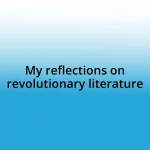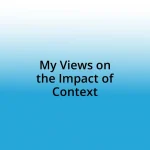Key takeaways:
- Understanding authorial intent enhances reader engagement and emotional connection with the text, influenced by personal experiences and context.
- Key theories like intentionalism and reception theory emphasize the dynamic interplay between an author’s intent and a reader’s interpretation.
- Analyzing literature for intent reveals deeper meanings and societal critiques, encouraging richer discussions in educational and book club settings.
- Challenges in interpreting intent arise from subjective perceptions, language nuances, and the author’s distance from their work post-publication.

Understanding authorial intent
Understanding authorial intent can be a profoundly enriching experience. When I first delved into this concept, I often found myself pondering: what drives an author to choose specific themes or characters? I remember being captivated by the novel “The Great Gatsby.” Fitzgerald’s intricate exploration of the American Dream resonated with me, leading me to think about how his personal experiences shaped his messages.
It’s fascinating when you consider that authorial intent isn’t always explicit and frequently requires us, as readers, to engage deeply with the text. I’ve noticed that sometimes, the meaning behind an author’s choices can stir unexpected emotions or challenge my beliefs. For instance, when I read a poem filled with imagery of loss, I could feel the weight of the author’s personal grief, prompting me to reflect on my own experiences with loss.
So, how can we truly unpack what an author intended? I often believe it requires a mix of context, empathy, and an open mind. During my own reading journey, I learned that understanding an author’s background, including their historical, cultural, and personal contexts, adds layers of meaning to their work. This exploration not only enriched my reading but also allowed me to appreciate literature on a much deeper level.

The role of author perspective
The author’s perspective shapes the narrative in ways that often go unnoticed. I remember reading a memoir where the author’s unique lens on their childhood illuminated aspects of my own upbringing. It made me realize that an author’s personal history can serve as a compass, guiding both the choices they make in storytelling and the emotions they evoke in readers.
As I contemplated various genres, I found that the author’s viewpoint transforms how themes are presented. For example, a thriller can feel entirely different if the protagonist’s perspective is shaped by a traumatic past. In one such story, the tension was heightened because I could sense the protagonist’s fears stemming from their experiences. That gave the narrative a richness that connected with me on a deeper emotional level.
When I reflect on different authors, I often notice discrepancies in how they perceive similar themes based on their backgrounds. This variation not only enhances the text but also invites discussions about our diverse experiences. Have you ever thought about how your viewpoint influences how you interpret stories? That’s where the magic lies; it’s not just about the author’s intent—it’s a shared journey of understanding, shaped by both the writer’s insights and the reader’s reflections.
| Author Perspective | Impact on Reader |
|---|---|
| Personal Background | Informs themes and characters |
| Emotional Engagement | Creates a connection reflecting personal experiences |
| Genre Exploration | Different emotional responses based on perspective |

Key theories on authorial intent
Understanding the key theories surrounding authorial intent opens up a fascinating dialogue about how literature is created and interpreted. For me, one dominant theory is the intentionalist perspective. This posits that an author’s intentions are paramount in interpreting their work. I recall a time when I struggled with a poem that felt almost cryptic until I explored the poet’s background. Learning about their activism profoundly affected how I perceived the nuances in their verses.
Another pivotal theory is the reception theory, which shifts the focus from the author to the reader’s experience. I remember reading an essay where the author argued that the meaning of a text isn’t fixed by the writer but rather constructed by each reader’s interpretation. This resonated with me deeply; I once felt entirely different emotions when revisiting a novel, discovering layers I hadn’t seen before. It highlighted how personal circumstances shape our readings.
- Intentionalism: The belief that understanding an author’s purpose is essential for interpreting their work.
- Reception Theory: Emphasizes the role of the reader in creating meaning from a text.
- Historical Context: Recognizes how the time period influences an author’s writing choices.
- Structuralism: Focuses on the text itself, analyzing its form without considering authorial intent.

Analyzing texts for intent
Analyzing a text for authorial intent involves delving into the layers of language and structure. I remember sifting through a classic novel where the author’s subtle use of symbolism revealed a deeper commentary on society. It made me reconsider every character’s dialogue, as I discovered how much the choice of words and imagery could convey about the author’s critiques and beliefs.
Sometimes, I ask myself how much context influences our reading of texts. For instance, I found that revisiting a dystopian novel during a pandemic added new dimensions to my understanding of the author’s warnings. Those layers of intent felt like hidden treasures waiting to be uncovered, blending my experiences with the author’s message in unexpected ways.
It’s fascinating to consider how authors embed their ambitions within the fabric of their narratives. While reading an obscure short story, I recognized a thread of rebellion against societal norms. It made me pause and reflect—how much of the author’s intention do we truly grasp, and how much is left for us to discover? This interplay between authorial intent and personal interpretation enriches every reading experience, making it intimately ours.

Practical applications of intent analysis
When I analyze a piece of literature for authorial intent, I often find myself grappling with the emotions behind the text. For instance, I recently revisited a novel that I loved in high school. This time around, I noticed the protagonist’s struggles reflected my own experiences with identity and belonging. It was eye-opening to realize how my personal journey altered my understanding of what the author intended to convey.
Another practical application of intent analysis is in education. I recall my time in a literature class where we discussed an author’s social context while reading their work. This combination brought new vitality to our discussions. By understanding how the author’s life experiences shaped their writing, my classmates and I discovered a newfound appreciation for the subtle messages woven into the narrative.
Have you ever considered how knowing an author’s intent can influence discussions in book clubs? I remember a lively debate over a book that ended up illuminating different perspectives each reader brought to the table. It always strikes me how intent analysis can enrich dialogue and deepen our connections to stories, as we piece together the intentions behind the author’s words with our personal insights.

Challenges in interpreting intent
Interpreting an author’s intent often feels like wandering through a labyrinth, where each twist might lead to a different understanding. I remember grappling with a contemporary novel that challenged my perception of cultural identity. The author’s message seemed crystal clear to some, yet others in my book club missed it entirely, leading me to wonder: Is the attempt to pin down ‘intent’ inherently subjective?
One significant challenge is the author’s inherent distance from their work once it’s published. I experienced this firsthand when discussing a poet’s collection that resonated with personal loss. A friend interpreted the sadness as purely autobiographical, while I insisted it could reflect the broader human experience. How do we reconcile our interpretations with the complicated tapestry of feelings that authors weave into their writing?
Additionally, the nuances of language add an extra layer of difficulty. As I navigated a complex short story during a recent reading group, I felt frustrated when others insisted on a singular interpretation. Their passion for one view made me question myself—was I missing something vital? It’s crucial to acknowledge that intent is not always a straight path; instead, it may require us to embrace ambiguity and open our minds to the many meanings that can arise from a single text.

Reflections on personal interpretation
When I reflect on my personal interpretations of literature, I often recognize how my life experiences shape my understanding. For example, I found myself immersed in a classic novel that once felt dull to me. This time, after navigating my own journey through heartbreak, the protagonist’s resilience resonated so deeply that it felt as if the words were crafted directly for my situation. Have you ever revisited a book only to find it transformed into a mirror of your own life?
I’ve also come to appreciate how the context of my surroundings influences my interpretations. During one particular read-through, the discussions in my favorite café with friends led to exhilarating insights. The blend of noise, laughter, and shared emotions allowed us to weave together diverse interpretations, showcasing how personal context can enhance or shift the meaning of a text. It raises a thought: can shared experiences create a richer tapestry of understanding than what the author originally intended?
Sometimes, the emotional weight of a narrative can hit me unexpectedly. In reading a story about family dynamics, I felt a pang of nostalgia as I recalled my childhood. Each character seemed to echo voices from my past, almost as if the author intended to evoke personal memories. It makes me wonder, how often do authors unknowingly create a space for readers to insert their own emotions and experiences? It’s in these moments of connection that literature blossoms, turning what might be a simple tale into a deeply personal journey.
















